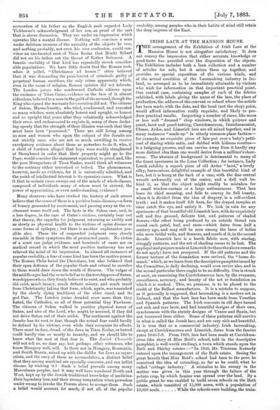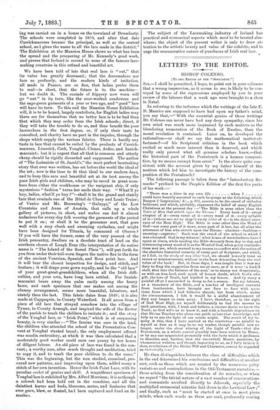IRISH LACE AT THE MANSION HOUSE.
THE arrangement of the Exhibition of Irish Lace at the Mansion House is not altogether satisfactory. It does not convey the impression that either accurate knowledge or good-taste has presided over the disposition of the objects. The Exhibition includes both a loan collection and a number of articles for sale, but it mixes them up together, and. provides no special exposition of the various kinds, and of the actual condition of the Lacemaking industry in Ire- land, so arranged as to be immediately attainable by visitors who wish for information on that important practical point, One central case, containing samples of each of the fabrics exhibited, with labels giving the name of the lace, the place of production, the address of the convent or school where the article has been made, with the date, and the local (not the shop) price, would afford information really requisite, and likely to pro- duce practical results. Inspecting a number of cases, like more or less well " dressed " shop windows, in which guipure and point, lacet and pearl-tatting, Carrickmacross, Innishmacsaint, Clones, Ardee, and Limerick lace are all mixed together, and in many instances " made-up " in utterly common-place fashion— for example, an exquisite piece of lace put over a baby's petti- coat of staring white satin, and dabbed with hideous rosettes— is a fatiguing process, and one carries away from it hardly any more distinct idea than one would derive from a milliner's show- room. The absence of background is detrimental to many of the finest specimens in the Loan Collection ; for instance, Lady Louth exhibits a superb piece of old Ardee " lacet," a lovely silky, harmonious, delightful example of this beautiful kind of lace, but it is hung at the back of a case, with the fine central wreath awkwardly out of the centre, and a dull wall be- hind it, so that the object might readily be mistaken for a small window-curtain or a large antimacassar. That lace loses its chief meaning, and fails to convey its full beauty, when it is divided from the idea of drapery, is a self-evident truth ; and it makes itself felt here, for the draped samples at once catch the eye, and satisfy it. We look in vain for any specimens of that beautiful old Limerick lace, with its exquisitely soft and fine ground, delicate tint, and patterns of shaded. flowers—the effect being produced by an outside thread run round each petal, leaf, And stem—which dates from half a century ago, and may still be seen among the laces of ladies who wore bridal veils, and flounces, and scarfs of it, in the second. decade. Limerick lace is a harsh fabric now, with staring, straggly patterns, and the art of shading seems to be lost. The appliqu4 and guipure made at Limerick (to these the above remarks do not apply) have not prospered. If the old patterns and the former texture of the foundation were revived, the "home de- mand," which, as we learn from the descriptive pamphlet issued by the Committee, is daily declining, would soon revive also, and in the iecond particular there ought to be no difficulty. One is struck at once, on examining the Carrickmacross lace, by the evenness, smoothness, accuracy, and beauty of the net or foundation on 'which it is worked. This, we presume, is to be placed to the credit of the Belfast manufacture. It is a mistake to suppose, as it generally is supposed, that lacemaking is a modern art in Ireland, and that the best lace has been made from Venetian and Spanish patterns. The Irish convents in old days turned out rich and rare laces, and had beautiful designs of their own, synchronous with the stately designs of Venice and Spain, but not borrowed from either. Some of these patterns still survive in what is called the Jesuit lace, and are very rich and beautiful. It is true that as a commercial industry, Irish lacemaking, except at Carrickmacross and Limerick, dates from the famine years 1846-7-8. From 1820, lace had been made at Carrickma- cross (the story of Miss Reid's school, told in the descriptive pamphlet, is well worth reading), a town which stands upon the Bath and Shirley estates :—"In 1846, Mr. Tristram Kennedy entered upon the management of the Bath estate. Seeing the great benefit that Miss Reid's school had been to the poor, he conceived the idea of extending, as far as he could, what he called cottage industry.' A stimulus to his energy in the matter was given in this year through the failure of the potato crop, by which famine was spread over the land. By a public grant he was enabled to build seven schools on the Bath estate, which consisted of 15,000 acres, with a population of 13,000 souls While the schools were building, the train-
ing was carried on in a house on the townland of DrumlustY. The schools were completed in 18E0, and after that date Carrickmacross became the principal, as well as the central sschool, an' gives the name to all the lace made in the district." The Exhibition at the Mansion House shows us what has been -the spread and the prospering of Mr. Kennedy's good work, and proves that Ireland is second to none of the famous lace- making countries in this refined and beautiful art.
We have been told of late that real lace is "out," that its value has greatly decreased ; that the dressmakers use lace so profusely, and the modern kinds of imitation, all made in France, are so fine, that ladies prefer them to real—in short, that the future is to the machine— lost we doubt it. The cascade of frippery now worn will go " out " in it turn, like the over-worked sunflowers and the sage-green garments of .a year or two ago, and " good" lace will have its turn. To this end the Mansion House Exhibition will, it is to be hoped, largely contribute, for English ladies may there see for themselves that no better lace is to be had than -that which they may order from the Irish schools ; direct, if they will take the trouble to do so, and thus benefit the poor lacemakers in the first degree, or, if only their taste be consulted, and charity have no part in the impulse, through the shops which supply the various fabrics. There is hardly any taste in lace that cannot be suited by the products of Carrick- macross, Limerick, Cork, Youghal, Clones, Ardee, and Innish- snacsaint ; but it is urgent that all that is common and utterly -cheap should be rigidly discarded and suppressed. The author of "The Lutaniste of St. Jacobi's," the most perfect lacemaking story that ever was written, has set before the world the ideal of the art ; now is the time to fit that ideal to our modern days, and to keep this rare and beautiful art at its best among the poor Irish girls and children, who may be saved in great num- bers from either the workhouse or the emigrant ship, if only mysterious " fashion " turns her smile their way. "What'll ye buy, ladies, what'll ye buy P"—shall it be the grand and stately lace that reminds one of the Hotel de Cluny and Louis Treize; of Venice and Mr. Browning's " Galuppi," of the Low Countries and Anne of Austria, that calls up a whole gallery of pictures, in short, and makes one feel it almost audacious for every-day folk wearing the garments of the period la put it on ; or shall it be the gossamer sort, that goes well with a rosy cheek and sweeping eyelashes, and might have been designed for Titania, by command of Oberon ? If you will have the former, some of the very poorest of the Irish peasantry, dwellers on a desolate tract of land on the acinthern shores of Lough Erne (the interpretation of its native name is "The Island of the Sorrel Plain"), will put forth for you from under their toil-worn fingers the native flax in the form of the ancient Venetian, Spanish, and Rose point lace. And it will bear the closest inspection for design, and stitch, and .texture; it will drape your gown royally, and be the "old lace" of your great-great-grandchildren, when all the Irish diffi- culties, and your own, have long been settled. For Innish- macsaint bears away the palm easily among the heavy laces, and each specimen that one makes out among the -clumsy arrangement, seems more beautiful, laborious, and -stately than the last. This fabric dates from 1849; it is also made at Cappoquin; in County Waterford. It all arose from a piece of old lace that strayed somehow into the village of Tynan, in County Armagh, and inspired the wife of the Rector -of the parish to teach the children to imitate it ; and the story of the Youghal lace, or "Irish Point," which is of surpassing
beauty, is very similar :—" The famine was sore in the land, the children who attended the school of the Presentation Con- vent at Youghal Wanted bread ; the only employment offered was muslin embroidery, at which it was then calculated that a moderately good worker could earn one penny by ten hours of diligent labour. An old piece of lace was found in the con- vent; a worthy nun, after much thought and meditation, tried to copy it, and to teach the poor children to do the same."
This was the beginning, but the nun studied, examined, pro- cured new patterns, and improving upon them, added many a stitch of her own invention. Hence the Irish Point Lace, with its
peculiar cachet of genius and skill. A magnificent specimen of
Youghal lace is exhibited by Mrs. Alfred Morrison; it is as though a cobweb had been held out in the sunshine, and all the -daintiest leaves and buds, blossoms, motes, and fantasies that ever grew, blew, or floated, hai been captured and fixed on its meshes. The subject of the La.cemaking industry of Ireland has practical and economical aspects which need to be treated else- where ; the object of the present writer is only to draw at- tention to the artistic beauty and value of the exhibits, and to urge the remunerative nature of purchases of Irish real lace.



































 Previous page
Previous page